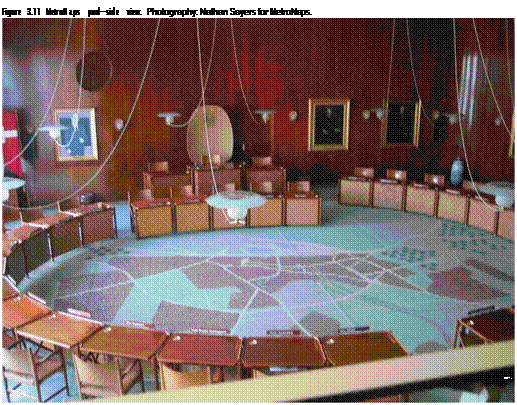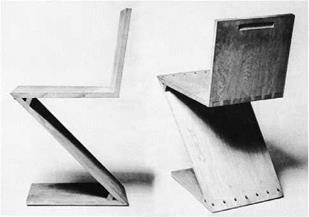This chapter focuses on the physical and spatial characteristics of furniture and is organized in three parts: Form, Spatial Organization, and Typological Orders.
FORM
Form constitutes the physical structure and spatial order of an entity; however, form is not a synonym for mass or three-dimensional volume. Music and poetry have structure as well as form. A drawing or sketch of a chair can express form just as a model of a chair might. When shape is governed by structural or cognitive consideration, it becomes form. We differentiate form in our mind as we perceive the activity of sitting in a chair. The Circle chair designed by Hans J. Wegner (1946) is considered form because its shape characteristics are determined by the structure of sitting in conjunction with the conditions of the chair’s geometry (Figure 3.1).
Consider the applied forces that can influence form (i. e., moment, shear, compressive, tensile, and lateral forces) resulting from gravity, daily use, and live loads. Reflect upon the sturdiness and strength that can be achieved by folding corrugated cardboard, as shown in Figure 3.2, or by the mechanical hardware in the Sciangai clothes stand designed by Jonathan de Pas, Donato d’Urbino, and Paolo Lomazzi (Figure 3.3). Think about how details, materials, form, hardware, and fabrication techniques help achieve structural integrity.
Periodic review of internal and external forces during design might help to develop a better understanding of how shear, moment, and lateral forces affect furniture. Quick study models and thoughtful, intuitive sketches can be helpful in considering applied forces in the early phases of design. Eventually, prototypes may need to be fabricated in order to test the structural integrity of a design. Furniture designers ought to be attentive to basic
|
 Figure 3.3 Sciangai clothes stand, designed by Jonathan de Pas, Donato d’Urbino, and Paolo Lomazzi (1973), manufactured by Zanotta. Photography by Jim Postell, 2006.
Figure 3.3 Sciangai clothes stand, designed by Jonathan de Pas, Donato d’Urbino, and Paolo Lomazzi (1973), manufactured by Zanotta. Photography by Jim Postell, 2006.
engineering principles throughout the design process and aware of concepts such as deflection, creep, and load failure as materials and dimensions are determined.
 Material selection and fabrication technique will influence form. Inversely, form can inspire the appropriate use of materials and fabrication processes. The natural figure and grain in wood inspired George Nakashima’s handcrafted furniture (Figure 3.4). The interlocking laminated and formed plywood components give order to Kristian Vedel’s children’s furniture, designed in 1957 (Figure 3.5).
Material selection and fabrication technique will influence form. Inversely, form can inspire the appropriate use of materials and fabrication processes. The natural figure and grain in wood inspired George Nakashima’s handcrafted furniture (Figure 3.4). The interlocking laminated and formed plywood components give order to Kristian Vedel’s children’s furniture, designed in 1957 (Figure 3.5).
Verner Panton’s stackable, free-form Panton chair (Figure 3.6) expresses the dynamic, fluid potential of rigid, injection-molded polyurethane in one piece. Originally formed from molded Baydur or hardened foam, technological advancement made in thermoplastics allowed re-edition in propylene in 1999 in red, black, blue, white, and yellow colors. It was the first chair made from a single material using the injection mold technique in a single form.
Form is influenced by the purposes it serves. In a chair or stool, the fundamental purpose may seem clear, yet there are many ways that people sit. This is evident in the wide spectrum of sitting devices available, ranging from inflated therapy balls to the upholstered settees of the Victorian period.
Consider the profile sketch of a laminated chair designed by
Erik Krogfl and the unfolding geometries that result from a study Figure 3.4 Conoid chair with an English wa|nut seat and hickory of the chair’s kinetic characteristics (Figures 3.7 and 3.8). The spindles, designed and crafted by George Nakashima (I960).
laminated plywood is staggered in an incremental manner, Photography by Jim Postell, 2005.
|
 which, along with its profile, creates a synthesis between the form or the chair, the desire for body movement, appropriate body support, and upright body posture.
which, along with its profile, creates a synthesis between the form or the chair, the desire for body movement, appropriate body support, and upright body posture.
Sit in a Mirra chair (Figure 3.9) designed by Studio 7.5 (2003) for Herman Miller, and experience the various body postures and range of body movement allowed by the chair’s active and passive adjustments. The backrest is a flexible, contoured, perforated panel of plastic held at four points by extensions of the backrest spine. The depth of the Mirra chair can be adjusted by raising or lowering the seat assembly, using a handle located below the seat. Experience the rocking motion in one of Ron Arad’s roto-molded polyethylene lounge chairs (Figure 3.10). These unique seating pieces integrate an anticipated experience with advanced technical fabrication processes, ergonomic consideration, social use, and aesthetics.
|
|
|
|
Furniture can create personal (private) and communal (public) space. Personal space is experienced in the MetroNaps pod, created in 2004 by MetroNaps. The reclining pod offers users a semiprivate space and invites quiet and individual repose (Figure 3.11). The MetroNaps pod is a personal place to recharge the mind and body—ideally situated for use in stressful environments such as airport terminals. In a different manner altogether, the arrangement of desks and chairs organized in a circular pattern in a town hall expresses the political ideal of individuals working together. The spatial order constitutes a collective and communal space (Figure 3.12).
|
 Figure 3.12 Tables and chairs arranged in a circular pattern, Town Hall in Arhus, Denmark. Photography by Julia Bryan.
Figure 3.12 Tables and chairs arranged in a circular pattern, Town Hall in Arhus, Denmark. Photography by Julia Bryan.
Form results from the many ways of thinking about structure, materials, function, social use, and technical considerations. Form also reveals measurable and spatial considerations, one of which is shape. Shape is dependent on descriptive geometry and in this section is organized into five categories: angular, composite, curvilinear, orthogonal, and sectional/ modular.
 Angular
Angular
All geometry is composed of points, lines, and planes. Canted, nonorthogonal and noncurvilinear geometries are Figure 3.13 Zig-Zag chair, designed and fabricated by Gerrit T. Rietveld, referred to as angular. Gerrit T. Rietveld’s stackable Zig-Zag
(1934). Photography: courtesy of John stork. chair (1934) is visually dramatic due to the bold angular rela
tionships between the chair’s support, seat pan, and seat back (Figure 3.13). The diagonal cantilever incorporates dovetailed, glued, and screwed joinery.








